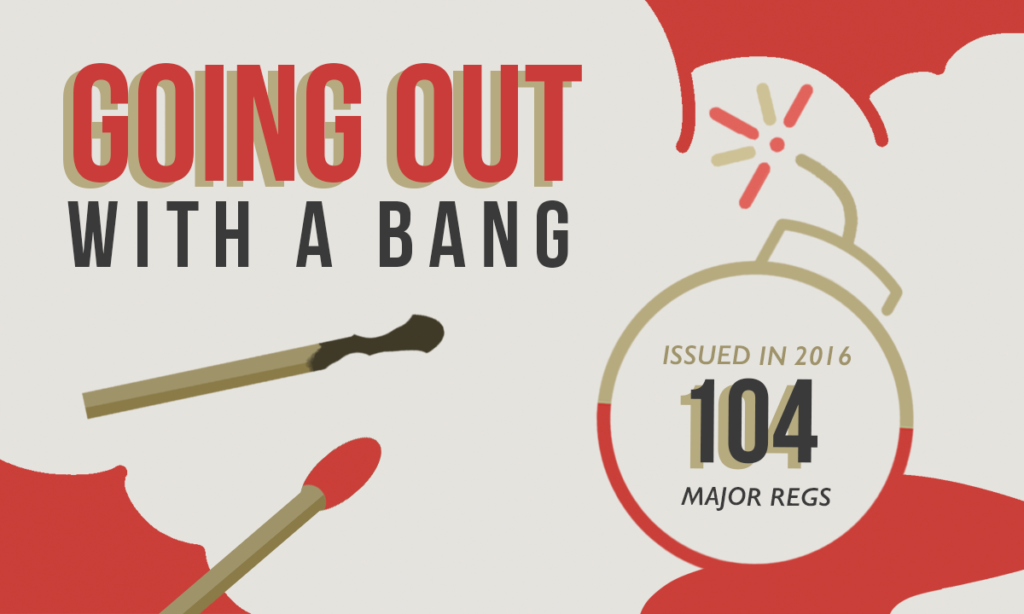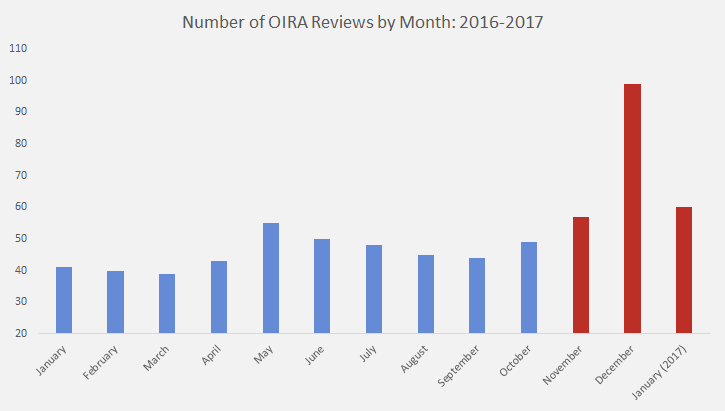Insight
January 23, 2017
Obama Administration Issued $157 Billion in Midnight Regulation

Since Election Day on November 8, 2016, the Obama Administration has published $157 billion in regulatory costs, with $41.2 billion from final rules alone. Last year, the American Action Forum (AAF) predicted the midnight regulatory total could approach $44 billion. Despite efforts to, “avoid midnight regulations,” (rules published after Election Day through Inauguration Day) the administration set records for December regulatory output and managed to publish more than a typical year’s worth of final rules in slightly more than two months. The “Vehicle-to-Vehicle” proposed rule makes up most of the balance between final and total regulatory costs. Expensive rules on energy efficiency ($12.3 billion) and natural gas emissions ($2.4 billion) led the administration’s last-minute regulatory push.
Throughout 2016, the administration averaged roughly 45 rules per month, including final and proposed measures. Then in November 2016, the administration managed to produce 57 rulemakings, an increase, but not statistically significant. By December, however, the administration approved more regulations (99) in that month than for any December since 1993. In other words, the Obama Administration more than doubled regulatory output in the month after the election. Was this due to good public policy or politics? January dispelled the notion that December was a statistical aberration after regulators released 61 rules in just 12 working days.
The graph below charts the explosion of “midnight” regulations.
Major Rules
According to the Office of Information and Regulatory Affairs (OIRA), the administration approved 38 major rules since Election Day. At that pace, roughly 0.79 per day, the administration would publish approximately 198 major regulations in a year (assuming 251 work days). For perspective, the Obama Administration is currently building on its own record from 2010, issuing at least 104 major regulations in 2016. The pace of major regulation and overall regulatory output demonstrably increased during the midnight period, but what led this uptick?
It wasn’t just the volume of rules, but the magnitude as well. Below are the largest regulations released during the midnight period:
- Efficiency Standards for Central Air Conditioners: $12.3 billion
- Efficiency Standards for Ceiling Fans: $4.4 billion
- Requirements for Commercial Vehicle Operators: $3.6 billion
- Public Land Natural Gas Flaring: $2.37 billion
- Renewable Fuels Standard: $1.55 billion
- Stream Protection Rule: $1.2 billion
The administration released 33 regulations with total costs exceeding $100 million during the midnight interim, totaling $40 billion in costs alone. The annual costs of these measures were less, at $8 billion. For paperwork, the largest rules generated 28.5 million hours of compliance time, led by a Federal Deposit Insurance Corporation (FDIC) recordkeeping rule, which will generate $478 million in costs and 5.2 million burden hours.
Rushed Rules
Some have advanced arguments that midnight regulations are a “myth” and that rules are not rushed during this period. However, there are several examples during the most recent midnight era that demonstrate regulators are willing to promulgate multi-billion-dollar rules without first seeking public comment.
For example, this $193 million interim final rule from the Department of Transportation (DOT) did not receive initial public comment and it took less than one year to complete. Likewise, this $12.3 billion direct final rule from the Department of Energy (DOE) was issued during the midnight period, as was this $2.6 billion rulemaking from DOE, which was initiated in late 2015. Contrary to claims that rulemakings take decades to complete (a few do), these major rules were issued without initial public comment and one took less than a year to finalize. When oversight committees scrutinize “rushed” rulemakings, these three are perfect architypes.
The average review time during the midnight period was 82 days, compared to 80 days before Election Day. This doesn’t necessarily prove rules are rushed or that midnight regulations are a myth. Broadly, the main argument stems from a statistically significant increase in regulatory activity after Election Day. With a doubling of regulatory output in December and a notable surge in January, this is undisputed. Some rules were rushed during the midnight period, but others had lingered with regulators for years, only to be issued during the midnight period. From an oversight perspective, the latter is less interesting than the former and the massive increase in output.
CRA Candidates
Congress seems poised to brush off the Congressional Review Act and repeal five to 20 eligible regulations, depending on the estimate. If this occurs, and President Trump signs the resolutions of disapproval, they “may not be reissued in substantially the same form.” Courts have yet to weigh in on the meaning of this clause, but it would effectively end an agency’s ability to regulate that subject matter until Congress re-delegates the authority or until an emboldened agency decides to test the bounds of what “substantially similar” means.
Regardless of textual interpretation, there are several midnight rules that Congress could scrutinize in the coming weeks. The top two candidates are discussed above, the Stream Protection Rule and the natural gas standards for federal lands. Congress could also examine the $12.3 billion direct final DOE standards for air conditioners or the recent $2.6 billion rule issued this week. Perhaps the 36 economically significant DOE rulemakings from the Obama Administration might convince Congress that DOE was too aggressive during the last eight years; for comparison, President Bill Clinton and George W. Bush combined for just ten during their two presidential tenures.
Conclusion
There is little doubt politics motivated some of the historic midnight surge from the Obama Administration. Publishing a year’s worth of regulatory burdens in less than three months is no easy task and yet the final gasps of the White House’s domestic agenda managed to produce $41 billion in final rule costs. Some successfully predicted this historic midnight output, but now Congress must move from these estimates to hard reality. Congress has the power to examine billions in regulatory costs and dozens of controversial measures. The Obama Administration’s historic regulatory output of 2016 could soon turn into historic regulatory modernization in 2017.











